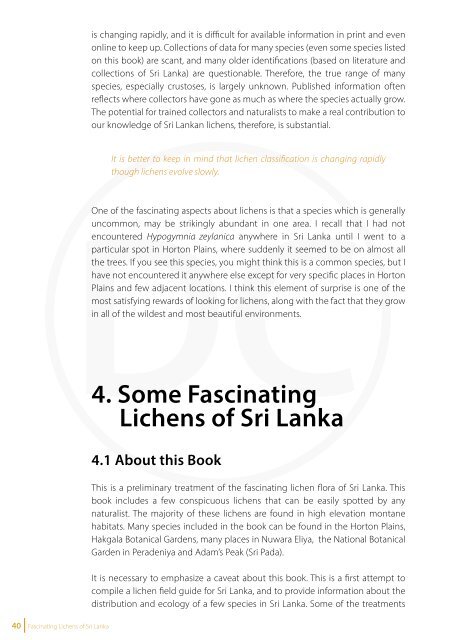Fascinating Lichens of Sri Lanka
Fascinating Lichens of Sri Lanka
Fascinating Lichens of Sri Lanka
- No tags were found...
Create successful ePaper yourself
Turn your PDF publications into a flip-book with our unique Google optimized e-Paper software.
40 <strong>Fascinating</strong> <strong>Lichens</strong> <strong>of</strong> <strong>Sri</strong> <strong>Lanka</strong><br />
is changing rapidly, and it is difficult for available information in print and even<br />
online to keep up. Collections <strong>of</strong> data for many species (even some species listed<br />
on this book) are scant, and many older identifications (based on literature and<br />
collections <strong>of</strong> <strong>Sri</strong> <strong>Lanka</strong>) are questionable. Therefore, the true range <strong>of</strong> many<br />
species, especially crustoses, is largely unknown. Published information <strong>of</strong>ten<br />
reflects where collectors have gone as much as where the species actually grow.<br />
The potential for trained collectors and naturalists to make a real contribution to<br />
our knowledge <strong>of</strong> <strong>Sri</strong> <strong>Lanka</strong>n lichens, therefore, is substantial.<br />
It is better to keep in mind that lichen classification is changing rapidly<br />
though lichens evolve slowly.<br />
One <strong>of</strong> the fascinating aspects about lichens is that a species which is generally<br />
uncommon, may be strikingly abundant in one area. I recall that I had not<br />
encountered Hypogymnia zeylanica anywhere in <strong>Sri</strong> <strong>Lanka</strong> until I went to a<br />
particular spot in Horton Plains, where suddenly it seemed to be on almost all<br />
the trees. If you see this species, you might think this is a common species, but I<br />
have not encountered it anywhere else except for very specific places in Horton<br />
Plains and few adjacent locations. I think this element <strong>of</strong> surprise is one <strong>of</strong> the<br />
most satisfying rewards <strong>of</strong> looking for lichens, along with the fact that they grow<br />
in all <strong>of</strong> the wildest and most beautiful environments.<br />
4. Some <strong>Fascinating</strong><br />
<strong>Lichens</strong> <strong>of</strong> <strong>Sri</strong> <strong>Lanka</strong><br />
4.1 About this Book<br />
This is a preliminary treatment <strong>of</strong> the fascinating lichen flora <strong>of</strong> <strong>Sri</strong> <strong>Lanka</strong>. This<br />
book includes a few conspicuous lichens that can be easily spotted by any<br />
naturalist. The majority <strong>of</strong> these lichens are found in high elevation montane<br />
habitats. Many species included in the book can be found in the Horton Plains,<br />
Hakgala Botanical Gardens, many places in Nuwara Eliya, the National Botanical<br />
Garden in Peradeniya and Adam’s Peak (<strong>Sri</strong> Pada).<br />
It is necessary to emphasize a caveat about this book. This is a first attempt to<br />
compile a lichen field guide for <strong>Sri</strong> <strong>Lanka</strong>, and to provide information about the<br />
distribution and ecology <strong>of</strong> a few species in <strong>Sri</strong> <strong>Lanka</strong>. Some <strong>of</strong> the treatments<br />
are preliminary, and in a few cases, as indicated in the text, there is considerable<br />
uncertainty regarding the application <strong>of</strong> a name for several species. Even with a<br />
few uncertainties, a field guide book such as this can be a useful tool in gaining<br />
an understanding <strong>of</strong> the local lichen biota and facilitating the availability <strong>of</strong><br />
accessible information. Out <strong>of</strong> hundreds <strong>of</strong> known lichen species in <strong>Sri</strong> <strong>Lanka</strong>,<br />
this book includes few <strong>of</strong> the macrolichens and very few conspicuous crustose<br />
genera with few examples.<br />
A serious observer will undoubtedly find many lichens that are not mentioned<br />
here since there are over 1000 lichens known from the country. I have not<br />
provided keys or extensive descriptions. Readers who wish to confidently identify<br />
lichens will need to consult primary sources. I would also encourage readers to<br />
consult the keys to lichens that are found in other published sources, as keys are<br />
the quickest route to identification. The Bibliography <strong>of</strong> this book lists some <strong>of</strong><br />
the important books on lichens, scientific journals that regularly publish articles,<br />
and a number <strong>of</strong> useful online resources. A number <strong>of</strong> lichens can be found with<br />
good photographs and extensive descriptions on the internet.<br />
In this guide, the lichens are arranged alphabetically by genus. For each genus<br />
included in this book, there is a heading with the genus (Genus), family (F),<br />
Order (O) and how many species are known in the world for each genus (W)<br />
followed by a brief synopsis <strong>of</strong> diagnostic features. This synopsis pertains only<br />
to those members <strong>of</strong> the genus listed in the book, and not necessarily to all<br />
members <strong>of</strong> the genus. Information on morphology, chemistry, and ecology<br />
is for the most part derived from central highland material, with emphasis on<br />
the lower elevations. In a few instances, I have based my comments on other<br />
Asian and temperate material, or relied on literature reports for taxa, particularly<br />
regarding sexual characters for species which are mostly sterile in <strong>Sri</strong> <strong>Lanka</strong>.<br />
Each lichen included in the book is given the species name, standard coding<br />
acronym used on field data (when available), and the growth form (foliose,<br />
fruticose, crustose etc.). This is followed by distribution, habitat, ecology, and<br />
any other information <strong>of</strong> importance about the lichen, as well as any diagnostic<br />
information on chemical constituents for further characterization <strong>of</strong> the species.<br />
The descriptions include distinguishing traits with as little technical jargon as<br />
possible. Thallus details include colour, shape, and unique features. Apothecia<br />
details are limited to where appropriate. Chemistry is included only when it is<br />
necessary to identify the species. Positive identification <strong>of</strong> lichens <strong>of</strong>ten requires<br />
chemical testing (it is best to do the chemical tests under a microscope when<br />
lichens are collected for further studies). The special notes include tips for field<br />
identification characteristics and similar species with which the subject lichen<br />
may be confused.<br />
<strong>Fascinating</strong> <strong>Lichens</strong> <strong>of</strong> <strong>Sri</strong> <strong>Lanka</strong> 41
















